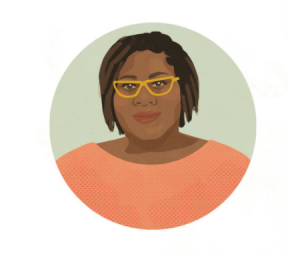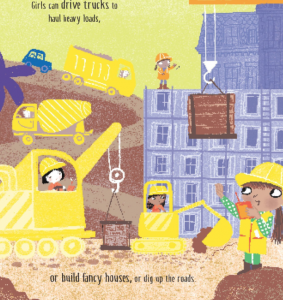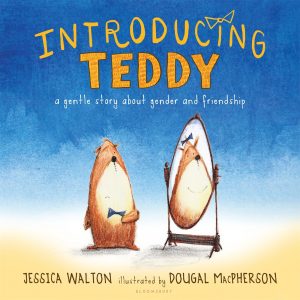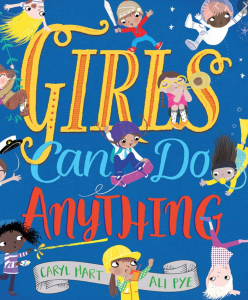Children’s Literature
Intersectionality and Feminist Values in Children’s Literature
by Kylie Landa
Why should we focus on intersectionality and feminist values in children’s literature?
Throughout my intro to Women’s and Gender Studies course this spring, I was baffled by the ideologies that were so important to understanding human individuality and rights. And yet, these ideas were not stressed in any of my previous academic settings. This was an awakening to me. I began to think about ways in which we can teach our future generations to be more inclusive and educated in order to shape a stronger community. As a society and through our schools, we must make big changes in order to accomplish greater acceptance, but small changes can be impactful as well. A simple way, and one that my own parents utilized while I was growing up, is teaching through children’s literature at home or in school. For this reason, I began to search for books that embody intersectional and feminist values and seek to empower young kids to be allies and advocates for themselves and those around them. As Dr. Kimberle Crenshaw says on page 7 of IntersectionAllies, “What might the future look like if all children were taught about justice, equity, and solidarity alongside the alphabet and arithmetic?”
IntersectionAllies; We make room for all
By: Chelsea Johnson, LaToya Council, and Carolyn Choi
Illustrated by: Ashley Seil Smith
This book not only has beautiful illustrations and a colorful appearance that will catch any child’s eye but also has a meaningful and important message. Created by Chelsea Johnson, LaToya Council, and Carolyn Choi, IntersectionAllies; We Make Room for All focuses on the importance of social consciousness and the goal of uniting across differences. From indigenous rights to gender equality, this book does a beautiful job painting a picture of how we can all be allies although we are all different,. The book also includes a “Letter to Grownups” that explains the purpose of the book and the message of “making room” for all. The end of the book includes book notes that dive deeper into the stories behind each character and page, prompting the reader to discuss and ask questions. It also includes important vocabulary and definitions for words like “intersectionality”, “feminism,” “hijab,” “gender,” “1.5 generation,” “#BlackLivesMatter,” and more! This book is educational yet fun and can act as a great tool when teaching a child the importance of accepting and supporting all those around you.
About the Authors:
All three of the authors are young sociologists who have recently formed the CLC Collective, which focuses on “publishing creative, relatable, and engaging sociology for all ages.” They were drawn to each other by a shared desire to “engage in scholarship, activism, and service that [transcends] the Ivory Tower.” All women of color, they have been inspired to make education surrounding intersectionality more accessible.

Chelsea Johnson earned a PhD in Sociology at University of Southern California. She attributes her feminism to childhood experiences as the “only black girl in [her] classrooms,” but it wasn’t until her undergraduate experience at Spelman college where she truly was introduced to what being a feminist looks and feels like. You can read more about Chelsea Johnson here.

LaToya Council was raised in a “single-mother-parented-home” where she saw the strength and heroism of her mother each day. That is what she says inspired her to strive for a more “inclusive world.”
She, like Chelsea Johnson, attended Spelman College and is currently working towards her PhD at the University of Southern California. Her dissertation focuses on “time use and self-care among Black middle-class couples.” If you would like to read more about Latoya Council click here.

Carolyn Choi studied Sociology and Korean Literature at UCLA during her undergraduate experience. After graduating she worked in Los Angeles doing advocacy work for Koreatown Immigrant Workers’ Alliance. After getting her masters from the London School of Economics, Choi went on to receive her PhD from the University of Southern California. Her work tackles issues around “migrant labor, human trafficking, and international education.” For more information on Carolyn Choi click here.

Influences:
The final pages of IntersectionAllies features books that inspired Johnson, Council, and Choi when writing their own story. With authors like bell hooks and Audre Lorde, it is no surprise that these women were inspired by some of the same minds that I had the opportunity to study over the course of the semester. The ideas of bell hooks and Audre Lorde shine through in IntersectionAllies with its focus on black feminism, indigenous feminism, intersectionality, and more.
Introducing Teddy: a gentle story about gender and friendship
Written By: Jessica Walton
Illustrated By: Dougal MacPherson
Well suited for young audiences (ages 3-6), Introducing Teddy reminds us that who you are much more important than what you are. Jessica Walton wrote this book when deciding how to tell her child about her own transgender parent. She also had the goal of diversifying children’s literature. In this sweet book, Errol notices his friend, Thomas, acting a little quieter than normal. Thomas doesn’t even want to go on the swing (one of his favorite activities)! Finally, Thomas confides in Errol and says, “In my heart, I’ve always known that I’m a girl teddy, not a boy teddy. I wish my name was Tilly, not Thomas.” Errol responds not with skepticism or questioning, but with unconditional love. “What matters is that you are my friend,” he tells Tilly.
About the Author: Jessica Walton
Jessica Walton is a an Australian writer and musician. Identifying as both queer and disabled, Walton continues to be a fierce advocate in speaking out against ableism and fosters acceptance and vulnerability within her work. After beginning to raise her child with her wife, Walton came to the realization that the diversity of her family was underrepresented in children’s literature. She was determined to change this. Since her book Introducing Teddy, Walton has written other books including Meet me at the Intersection which includes a variety of authors with diverse backgrounds. The authors use these various perspectives to help paint a picture of how intersectionality manifests itself in Australian life.
Things to keep in mind:
Walton describes a situation in which, when speaking out about who she really is, Tilly is immediately accepted with love and warmth. In the grand scheme of the book, Tilly’s transition, from a “boy teddy” to a “girl teddy”, is really no big deal at all. This may not represent the typical transgender experience, but teaching our children this easygoing openness has the potential to impact that.
Influences:
Leslie Feinburg stresses the importance of defending gender freedom in her piece To Be or Not To Be. She notes that we must defend “the right of each individual to express their gender in any way they choose, whether feminine, androgynous, masculine, or anywhere on the spectrum in between.” This, Feinberg says, “includes the right to gender ambiguity and gender contradiction.” Walton gives a nod to this idea of gender freedom in her book Introducing Teddy with her demonstration of love and acceptance for Tilly’s choice to be who she truly is.
Girls Can Do Anything
Written By: Caryl Hart
Illustrated by: Ali Pye
This colorful and fun book by Caryl Hart shows girls of all different colors, shapes, and sizes doing anything they set their minds to. Some girls are neat and some girls are messy. Some girls are great at science and math and some girls excel in sports. Some girls are good at arts and crafts and some girls are good at speaking out for others during difficult times. But, nonetheless all girls are “fantastic, strong, brave, and proud.” Among its fun illustrations and melodic rhyming, the book features some powerful historical women. From the first deaf African American attorney, Claudia Gordon, to the first female and openly LGBTQ person to win a boxing gold medal at the Olympics, Nicola Adams, Hart chooses to recognize women that kids may not traditionally learn about. Whether you are an astronaut or a construction worker, Hart proves to young girls it is not about being the best in the world, but being the best you can be. She stresses that success, just like people, comes in all different shapes and sizes and you do not need to be a record breaker to be a powerhouse.

About the Author: Caryl Hart
Caryl Hart grew up with “no positive female role models”. She deemed herself a “tom-boy” from a young age and viewed being a woman as an “annoyance”, one that would set her back when chasing her dreams. To make it even more difficult, Hart was only ever taught about the historic contributions of men, but never women. It wasn’t until she got older that her perspective changed. Today she wants children to know that “there is nothing about a person’s gender that dictates the things they are allowed to be interested in or the careers they choose to enter.” When choosing what women to feature in the gallery on the final pages of the book, Hart made an effort to steer away from the same “old fusty historical figures” we always hear about and chose to pick women she thinks deserve more attention and recognition. She also made it a goal to diversify the people in her book so that “every child could find a character they had something in common with.” Click here to read an interview with Caryl Hart.
Things to keep in Mind:
This book is very “girl” specific and occasionally feels limiting to those who may not identify as strictly female. However, I believe that we as a society need reminders about the power of women and the unlimited capabilities they have. I also believe it is an important idea to teach our children that girls, like boys, are capable of doing anything.
Influences:
One of my favorite pieces from my semester in Women’s and Gender Studies comes from the talented Marge Piercy. In her poem, My Heroines, Piercy describes the power of all women. Whether you are a woman behind the scenes, an encouraging mother, or a groundbreaking female leader, your contributions are what make the world go round. Just like Piercy, Hart recognizes the diverse and important roles that women play in society, while noting how each woman has the ability to be powerful in whatever path she pursues.


